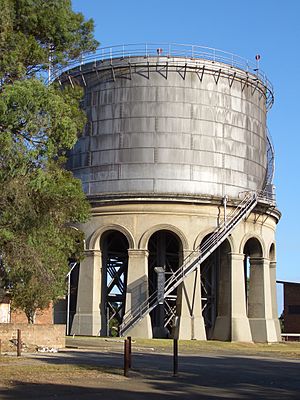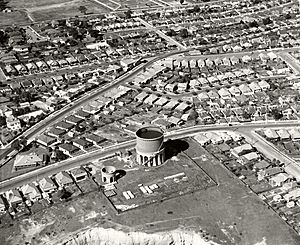Ashfield Reservoir facts for kids
Quick facts for kids Ashfield Reservoir |
|
|---|---|

Ashbury water reservoir, in October 2008
|
|
| Location | Holden Street, Ashbury, City of Canterbury-Bankstown, New South Wales, Australia |
| Built | 1912 |
| Built for | Metropolitan Board of Water Supply and Sewerage |
| Architect | Metropolitan Board of Water Supply and Sewerage |
| Owner | Sydney Water |
| Official name: Ashfield Reservoir (Elevated) (WS 0003); WS 0003 | |
| Type | State heritage (built) |
| Designated | 15 November 2002 |
| Reference no. | 1622 |
| Type | Water Supply Reservoir/ Dam |
| Category | Utilities - Water |
| Builders | Metropolitan Board of Water Supply and Sewerage |
| Lua error in Module:Location_map at line 420: attempt to index field 'wikibase' (a nil value). | |
| Reservoir | |
| Total capacity | 1,000,000 imperial gallons (4.55 Ml) |
| Maximum water depth | 39 ft 2 in (11.94 m) |
| Normal elevation | 220 ft (67 m) |
The Ashfield Reservoir is a special water tank located in Ashbury, New South Wales. It's listed as a heritage site, which means it's an important historical place. The Metropolitan Board of Water Supply and Sewerage designed and built it. Today, Sydney Water owns this reservoir. It is also known as Ashfield Reservoir (Elevated) (WS 0003). It was added to the New South Wales State Heritage Register on 15 November 2002.
Contents
History of the Area
Early European Settlement
The first European land grant in Canterbury was given to Reverend Richard Johnson in 1793. He was the colony's first chaplain. He named his 40 hectares (100 acres) farm "Canterbury Vale," which is how the suburb got its name.
By 1800, the property had grown to 240 hectares (600 acres). It was sold to Lieutenant William Cox. In 1803, when it was 360 hectares (900 acres), it was sold again to Robert Campbell. He then bought most of the land north towards Liverpool Road.
The village of Canterbury started to form after 1841. This happened when parts of Campbell's land were sold off. People bought land west of Canterbury Road and north of the railway. Other sales followed in the 1840s and 1850s.
Even though the soil was not very good, some farming took place. The main jobs were cutting and carting wood, and making bricks. In 1840, the Australian Sugar Company bought 24 hectares (60 acres) of Campbell's land. A steam engine was installed, but the factory closed in 1856.
The first post office opened in 1858. The first official public school opened in 1878. The area slowly grew over time. Canterbury Race Course, on the Cooks River, has been a major racetrack since 1871. The railway station opened in 1895.
Building the Reservoir
The Ashfield Reservoir (Elevated), also known as WS 3, was built in 1912. It is one of four similar elevated reservoirs in the Sydney Water system. The others are Bellevue Hill Reservoir (WS 10), Drummoyne Reservoir (Elevated) (WS 38), and Penshurst Reservoir (Elevated) (WS 87). All these were built around 1910-1912.
Originally, water from Petersham Reservoir supplied western Sydney. A pumping station at Carlton helped lift water to Penshurst. This supplied higher areas like Kogarah.
Water from Woollahra Reservoir used to be sent to Ashfield Reservoir (built in 1888). This helped supply higher areas in the Inner West. By 1927, an extra pipe from Potts Hill also supplied the Ashfield Reservoir. Today, the reservoir gets its water from the City Tunnel.
What the Reservoir Looks Like
The Ashfield Reservoir (Elevated), WS 3, is a large, round steel tank. It sits high up on a steel frame. The bottom of the tank rests on a concrete base. The steel frame has a decorative outer layer of concrete columns and arches. These columns and arches are for looks, not for holding up the tank.
There is a walkway around the top edge of the reservoir. It is attached to the outside and supported by brackets. The reservoir also has a handrail, a crane-like tool called a davit, and an access ladder. There is also a special marker for surveying.
When full, the reservoir can hold 1,000,000 imp gal (4.5 ML) of water. Its full service level is 260 feet (79.25 m) high.
The site also has workshops and offices. You can also access the Pressure Tunnels from here. There are two small "skid huts" on the grounds. These huts are rare and show what working conditions were like for the water board employees in the past.
The reservoir had a roof added in the 1960s or 1970s. This was done to keep the water clean and safe.
Why It's a Heritage Site
The Ashfield Reservoir (Elevated) (WS 3) is one of only four similar elevated reservoirs in the Sydney Water system. The others are Bellevue Hill Reservoir (WS 10), Drummoyne Reservoir (Elevated) (WS 38), and Penshurst Reservoir (Elevated) (WS 87). These reservoirs show amazing engineering skill and beautiful architectural details. They combine strong structures with a nice appearance.
The Ashfield Reservoir was listed on the New South Wales State Heritage Register on 15 November 2002. It met several important requirements:
- It shows the history of New South Wales.
* The Ashfield Reservoir is part of a small group of four similar elevated reservoirs. These show how water supply systems developed in NSW.
- It shows great design and technical skill.
* This group of reservoirs demonstrates very high levels of engineering and architectural design. This combination of strong structure and beauty is rare in NSW. * The reservoir is also a well-known landmark in the area.
- It can teach us about history.
* This reservoir shows the high level of technical skill available to the Metropolitan Board of Water Supply and Sewerage when it was built.
- It is rare or uncommon.
* This reservoir is one of only four riveted steel elevated reservoirs in the Sydney Water system. It's even rarer because of its detailed architectural design. The "skid huts" on the site are also very rare to find today.
- It shows important features of its type.
* Using a riveted steel tank was common for ground-level reservoirs. However, it was extremely rare to combine this with an elevated steel frame and concrete base.


